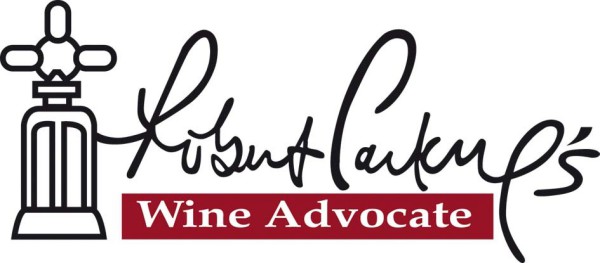
Several of our favorite wines from Domaine Marc Kreydenweiss received scores of over 90 points on ERobertParker.com!! First, a little about the winery:
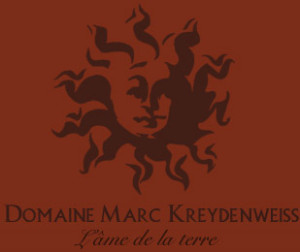 “Probably Andlau, a small village in a small valley in the Bas-Rhin region in the northern part of Alsace is not the first address for those who love big, rich, round and powerful wines with loads of accessible fruit. However, to supporters of rather light, pure (or naked), lean, dry, racy and uncompromisingly mineral wines with great aging potential the 13 hectare Domaine Kreydenweiss might be one of the most finest Alsatian addresses. Since the vines root in highly diverse yet always acidic soils here (mainly on red sandstone, granite and two kinds of slate) and benefit from a late ripening (one up to two weeks after Colmar) they are never big or broad but lean and linear and borne by a pronounced, salty and rather ‘vertical’ acidity. Mainly the Rieslings but also Pinot Gris and Gewurztraminer from Andlau can taste so edgy and stony as if you were biting on rocks –– but they are vibrant with energy! These characteristics meet fabulous with Antoine’s personal style and preferences.
“Probably Andlau, a small village in a small valley in the Bas-Rhin region in the northern part of Alsace is not the first address for those who love big, rich, round and powerful wines with loads of accessible fruit. However, to supporters of rather light, pure (or naked), lean, dry, racy and uncompromisingly mineral wines with great aging potential the 13 hectare Domaine Kreydenweiss might be one of the most finest Alsatian addresses. Since the vines root in highly diverse yet always acidic soils here (mainly on red sandstone, granite and two kinds of slate) and benefit from a late ripening (one up to two weeks after Colmar) they are never big or broad but lean and linear and borne by a pronounced, salty and rather ‘vertical’ acidity. Mainly the Rieslings but also Pinot Gris and Gewurztraminer from Andlau can taste so edgy and stony as if you were biting on rocks –– but they are vibrant with energy! These characteristics meet fabulous with Antoine’s personal style and preferences.
The wiry young man with the small goatee drives an electric car (a white Kangoo which is the opposite of a stylish black SUV that seems to be sailing through the vineyards due to its quietness) and aims for ‘naked’, low-sulfured, terroir-driven wines: “I am going for the texture and structure of a wine. I am less interested in the nose because it changes every single day anyway. I am looking for the terroir character in the mouth. I want to taste the vintage and the terroir. So we don’t add anything and we don’t take anything as well.”
Superfluous to mention that Kreydenweiss is biodynamic –– since more than 25 years now.
Antoine took over the responsibility of the old family domaine in 2007. One year later his father Marc moved to the Costières de Nîmes, Rhône valley, to run the other part of the Domaine Kreydenweiss. With Antoine the Alsace wines have possibly become even more radical. He cultivates two kind of plantations: 5000 vines per hectare (with tractor) and 10000 vines (with the horse). The domaine has no clones, just mass selections, mainly from the Kastelberg and from other vignerons Alsaciens. Antoine also picks a little bit earlier than his father did to keep the freshness in the wines and the alcohol levels moderate. He extended the élevage on the full lees of the wines, especially the crus up to at least 15 but, depending on the vintage and the wines, also 24 months whereas he reduced the addition of SO2 to a minimum (or even zéro for bottlings that are – still? – meant as an alternative to the regular wines like the Kritt Pinot Blanc). All his wines undergo the malolactic fermentation and he has no problem at all to talk about this natural process of stabilization (in contrast to most of his German colleagues).
In the cellar everything is moved by gravity. Inox tanks are used just for the settlement after the passing whereas all the fermentations and the élevage take place in large wooden barrels of 1000 to 7400 liters which are up to 80 years old.
Since the expression of the particular terroir has always been the main goal of the domaine it is not the grape variety that is communicated on the wine labels but the the single vineyard site: either the Grands Crus Wiebelsberg, Moenchberg or Kastelberg or the potential Premiers Crus which are self-assured indicated as “Cru d’Alsace” on the labels. Luckily, all these highly interesting and age-worthy wines of the Alsatian part of the Domaine Kreydenweiss are back in the US market after they had been absent for a while.”-Stephen Reinhardt, eRobertParker.com
2010 Domaine Kreydenweiss Riesling Grand Cru Kastelberg-91pts
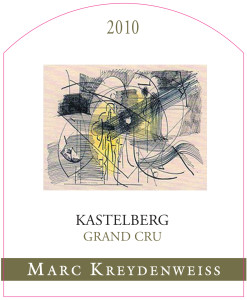
“Kreydenweiss’s 2010 Riesling Kastelberg – bottled in September of 2012 which is relatively early by the standards of Riesling from this vintage collection – delivers smoky, zesty, saline notes on the nose as well as on a sappy palate that are very consistent with the performances put in by most wines in that collection. Mirabelle, peach kernel, gooseberry, toasted almond and pip as well as rind of lemon make for a penetratingly high-toned and piquant personality, whose underlying stoniness adds to an overall impression of severity. This slate-tipped arrow of a Riesling should merit following through at least 2025. And I would expect it to hold much in reserve for its first half dozen years in bottle. (The analytically similar 2008, tasted alongside, is even more than when last tasted for issue 194, a superb model of complex clarity and penetrating elegance.) A Muenchberg 2010 also tasted alongside was however so awkwardly reduced and inscrutable that I have not published my tasting note, and I have unfortunately not had chance to re-taste it.”
2010 Domaine Kreydenweiss Pinot Gris Clos Rebberg-90pts
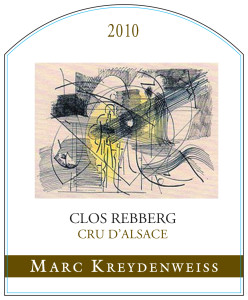
“Smoky-sweet machine oil, kirsch, peach kernel, toasted hazelnuts, oceanic salinity and alkalinity a well as a hint of saffron fascinatingly mark the nose as well as the firm, full palate of Kreydenweiss’ 2010 Pinot Gris Clos Rebberg. This bottling’s salty, piquant persistence doesn’t quite bring with it the primary juiciness found in the present collection’s most successful offerings, but there is still impressive and zesty sheer persistence. Plan to revisit this in 2014 or 2015 but to tentatively keep revisiting through at least 2018.”
2009 Domaine Kreydenweiss Pinot Gris Grand Cru Moenchberg-91pts
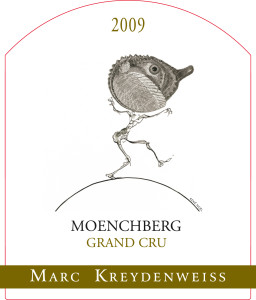
“Honeydew melon and walnut oil offer a lovely counterpoint of lusciousness and piquancy in Kreydenweiss’s 2009 Pinot Gris Moenchberg, which boasts a profusion of iris and musky narcissus-like perfume that persists on its silken-smooth palate and into a long, bittersweet finish tinged by melon rind and smoky hints of black tea. I expect that this in every respect polished performance will be worth following for 15 or more years.”
2011 Domaine Kreydenweiss Pinot Gris Grand Cru Moenchberg-92+pts
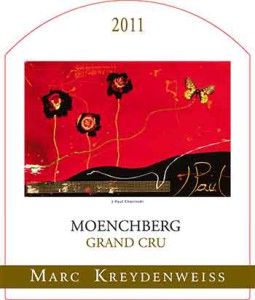
“The vines planted for the 2011 Pinot Gris Moenchberg Grand Cru in the early 1980s root ins sandstone and marl soils. “The Moenchberg is a very good place for late harvest wines, but in 2011 we picked the grapes very early. We try to produce this wine as dry as possible but we don’t succeed in all the years”, says Antoine Kreydenweiss. The 2011, however, fermented nearly fully dry and was bottled with less than 5 grams per liter of residual sugar and 14% alcohol. Fermented in three 600 liter barrels it opens with a rich and intense nose of lemon aromas and some fumé flavors yet demands a lot of aeration to open up. Rich, intense and powerful on the palate, this full-bodied, round and elegant wine is creamily textured yet surprisingly fresh as well and provided with helpful oak tannins which built up the structure of this complex and persistent wine. Antoine does not really know how to explain the vibrant acidity (which is quite unusual for 2011). “Well, it must be the soil,” he says.”


